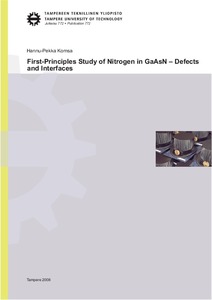First-principles study of nitrogen in GaAsN - Defects and Interfaces
Komsa, H.-P. (2008)
Komsa, H.-P.
Tampere University of Technology
2008
Luonnontieteiden ja ympäristötekniikan tiedekunta - Faculty of Science and Environmental Engineering
This publication is copyrighted. You may download, display and print it for Your own personal use. Commercial use is prohibited.
Julkaisun pysyvä osoite on
https://urn.fi/URN:NBN:fi:tty-200902201011
https://urn.fi/URN:NBN:fi:tty-200902201011
Tiivistelmä
Semiconductors are an essential part of the modern society. Transistors, solid- state lasers, solar cells, and several other semiconductor devices have shaped the world drastically. The most familiar material is perhaps silicon found in all the computer chips. Optoelectronic components, on the other hand, are usually based on materials such as GaAs, which already has a long history. On the contrary, the potential of dilute nitride GaAsN material, which is the subject of this thesis, was only recently discovered.
The rapid progress of semiconductor technology would have been impossible without basic materials research, which in the recent years have ever-increasingly taken the form of computational research (fittingly, executed on a piece of silicon). For new materials, the first-principles methods which do not rely on any empirical parameters are important on predicting the unknown material properties reliably. More precisely, we have employed the density-functional theory, which is a good compromise between speed and accuracy.
Various GaAsN material properties show unconventionally strong non-linear dependence as a function of the nitrogen concentration. These properties originate from the notable concentration of nitrogen up to alloy concentrations, although nitrogen is essentially a defect forming a deep resonance state. The purpose of this thesis is to understand nitrogen in various environments typically encountered in practical devices. However, the limitations of the methods need to be understood and carefully controlled in order to obtain meaningful results. Moreover, the interpretation of the computational results, and matching with the experimental results, is not always straightforward. These considerations are then an inseparable part of the discussion.
First, the isolated nitrogen defects in GaAs are discussed. This includes our studies of interstitial nitrogen, where we have found the most likely locations for interstitial nitrogen as a function of Fermi-energy and growth conditions. Nitrogen concentration is then increased up to alloy concentrations, and the properties are investigated relying mostly on the extensive studies presented in the literature. After obtaining understanding of dilute nitrides, we can apply it to more complex systems.
The nitrogen interaction with other material components is studied in the last part of the thesis and comprises a large part of our research: The study of the beryllium doping effect on nitrogen alloying and nitrogen effect on beryllium defects allows us to find the causes for the experimentally observed p-type carrier compensation and observe cancellation of nitrogen-induced band-gap reduction. Our computational studies are used in the interpretation of the Raman spectra of nitrogen-related vibrational modes in InGaAsN. Finally, the GaAsN/GaAs and InGaAsN/GaAs interface calculations show a long-range interaction due to nitrogen and a strong valence-band offset dependence on the local geometry of nitrogen and indium.
In many instances, this thesis displays how seemingly surprising results of more complex systems can be explained by relying only on a few fundamental physical concepts of isolated defects or simple alloys. The role of computational physics is then to find (more) quantitative values and the winner among the competitive situations.
The rapid progress of semiconductor technology would have been impossible without basic materials research, which in the recent years have ever-increasingly taken the form of computational research (fittingly, executed on a piece of silicon). For new materials, the first-principles methods which do not rely on any empirical parameters are important on predicting the unknown material properties reliably. More precisely, we have employed the density-functional theory, which is a good compromise between speed and accuracy.
Various GaAsN material properties show unconventionally strong non-linear dependence as a function of the nitrogen concentration. These properties originate from the notable concentration of nitrogen up to alloy concentrations, although nitrogen is essentially a defect forming a deep resonance state. The purpose of this thesis is to understand nitrogen in various environments typically encountered in practical devices. However, the limitations of the methods need to be understood and carefully controlled in order to obtain meaningful results. Moreover, the interpretation of the computational results, and matching with the experimental results, is not always straightforward. These considerations are then an inseparable part of the discussion.
First, the isolated nitrogen defects in GaAs are discussed. This includes our studies of interstitial nitrogen, where we have found the most likely locations for interstitial nitrogen as a function of Fermi-energy and growth conditions. Nitrogen concentration is then increased up to alloy concentrations, and the properties are investigated relying mostly on the extensive studies presented in the literature. After obtaining understanding of dilute nitrides, we can apply it to more complex systems.
The nitrogen interaction with other material components is studied in the last part of the thesis and comprises a large part of our research: The study of the beryllium doping effect on nitrogen alloying and nitrogen effect on beryllium defects allows us to find the causes for the experimentally observed p-type carrier compensation and observe cancellation of nitrogen-induced band-gap reduction. Our computational studies are used in the interpretation of the Raman spectra of nitrogen-related vibrational modes in InGaAsN. Finally, the GaAsN/GaAs and InGaAsN/GaAs interface calculations show a long-range interaction due to nitrogen and a strong valence-band offset dependence on the local geometry of nitrogen and indium.
In many instances, this thesis displays how seemingly surprising results of more complex systems can be explained by relying only on a few fundamental physical concepts of isolated defects or simple alloys. The role of computational physics is then to find (more) quantitative values and the winner among the competitive situations.
Kokoelmat
- Väitöskirjat [4769]
